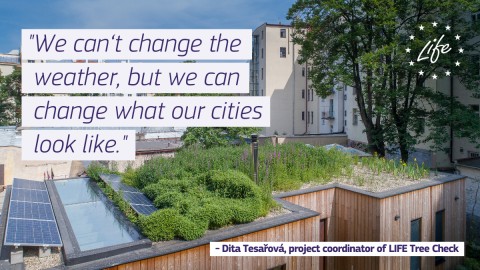The last 5 years have been the hottest on record. Temperature records were broken in cities across Czechia, Spain, Germany, France, and Poland. Meanwhile, public health warnings were issued in Belgium, Italy, and Switzerland due to the intense warmth. The team at LIFE Tree Check has come up with several solutions that can help cities across central Europe cope when the heat is on.
Such extreme weather is set to continue and even worsen due to climate change. Urgent solutions are needed, especially in urban areas.
To help Europe respond to this challenge, the European Commission will publish a new EU Adaptation Strategy in early 2021. This strategy is part of the European Green Deal and builds on the current successful plan adopted in 2013.
Heat islands
‘Temperatures in cities are several degrees higher than in the countryside,’ explains LIFE Tree Check project coordinator Dita Tesařová. ‘Scientists call this effect “heat island” and it is caused by all the buildings, cars, asphalt, as well as the lack of greenery and water in urban areas.’
The project involves partners from Czechia, Hungary, Poland, and Slovakia, who all want to increase green infrastructure in their cities. Examples of this green infrastructure include natural features like trees and water bodies that offer a wide range of ecosystem services and protect biodiversity.
The team of scientists, analysts as well as urban management and green infrastructure experts has been looking closely at eight pilot cities across the four partner countries to gauge the situation on the ground. The goal is to capture the views of ordinary people as well as those who make decisions on green infrastructure investments.
Instant recognition
For the public, a mobile application is being developed that not only recognises specific types of plants and trees when they are photographed; it can also show the user how these species can help improve a city‘s climate. The application will be available for download next spring.
The team has also set up an online database featuring green infrastructure projects from the four target countries. Examples include green buildings, a green bus stop draped in vegetation and ivy, wetland roofs, and even a sustainable drainage system.
Individuals and organisations can also apply for the Adapterra Awards, which will recognise the most inspirational green infrastructure projects. It is expected that the Awards will encourage others to also get involved.
In addition, the Tree Check manual will explain to the public how climate change impacts our cities and their development.
A series of training workshops are on offer, not only for lawmakers but for those working in urban development. People thinking of starting their own green infrastructure projects will also be able to attend.
Return on investment
An online tool, due to be launched in December this year, will be able to predict the benefits of various green infrastructure investments on a given city‘s climate. This information will be important for lawmakers so that they can make the right decisions when it comes to investing in such projects. Support is also on offer for authorities wanting to do the same.
‘We can‘t change the weather, but we can change what our cities look like. Energy-saving buildings, green facades and roofs, bushes, grass and water features – they all help our cities cool down, creating a pleasant and comfortable place to live in. Who doesn’t want to live in a city like that?’ concludes Dita.
ec.europa.eu


















